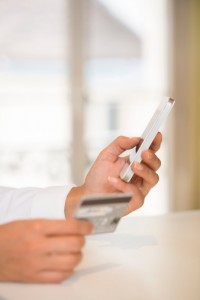Mobile On the Move: Make Security a Priority
 Are you ready for mobile payments? With more consumers ready to pay with a tap, you’re likely planning how to incorporate mobile payments into your systems. Even as you focus on the high-tech, it’s critical to remember to also focus on high-security.
Are you ready for mobile payments? With more consumers ready to pay with a tap, you’re likely planning how to incorporate mobile payments into your systems. Even as you focus on the high-tech, it’s critical to remember to also focus on high-security.
Apple is just the first bite
The September announcement of Apple Pay was heralded as a groundbreaking change in the way consumers pay for goods. The truth, of course, is that mobile payment technology has been around for years — it just hasn’t been used much. Few merchants have had the technology to accept mobile payments, so few consumers have used their mobile wallets. Likewise, without large-scale consumer demand, merchants really haven’t had a reason to add mobile payment acceptance devices.
However, Apple’s announcement makes mobile payments a higher priority for merchants for one very good reason: Lots of people own iPhones.
Treat mobile security as seriously as all your security
In addition to having a broad user base, Apple’s security measures are sound, so more people will be likely to embrace the idea of paying with their phones. As merchants become increasingly active in mobile marketing, and encourage sales to mobile customers with many different kinds of devices, they’ll want to remember that mobile transactions are not automatically safe.
Some mobile devices are easy to hack and many users are especially vulnerable because they tend to store lots of personal data on them. It’s critical to create the same layer of security for mobile as you do for all other transactions.
In addition, information stolen from these devices might include sign-on details and other account data for your store, making it a snap for crooks to change account details and then place and direct fraudulent orders to their own location.
Accordingly, you need to use exactly the same tools as you do in other channels to identify red flags from incoming mobile transactions — for example, multiple orders or cards from the same address, big ticket items, new customers, and overseas orders.
Also, be aware that hacked mobile devices can be programmed to spoof their location. In other instances, some devices may not even yield geo-location details, so you can’t tell where the mobile device is being used. Or, they may not store cookies that would verify previous business.
Best approach
The best approach is to maintain your highest security for all transactions. If you provide customers with your own mobile app, ensure that it has the same security level as your online store, including passwords, security questions, and data encryption.
Then, be sure that all transactions go through the same back-end systems as your desktop/laptop and POS transactions.
This “unified security” approach means that you can manage both mobile and other online transactions with the same level of scrutiny. It also streamlines the process of integrating data from all channels (including in-store and call center transactions), increasing the likelihood that you’ll spot fraud attempts much more quickly.
By taking these steps, you’re not only protecting yourself against fraud, but also protecting your reputation. Customers will be more likely to use your mobile channel if they know they can do so securely.
[cta]Are you on track for mobile payment acceptance? Contact us at 866-944-0055 or by email to learn how we can help.[/cta]
